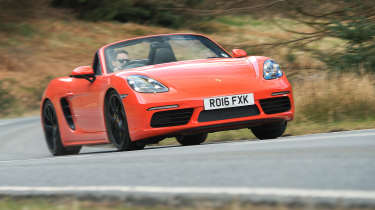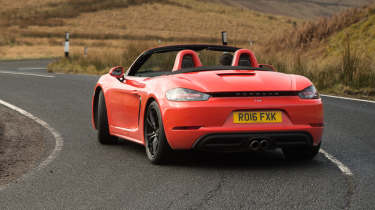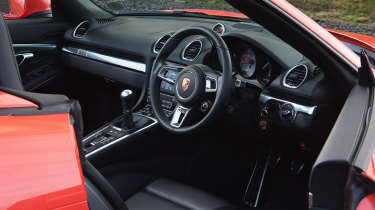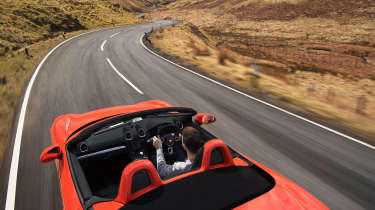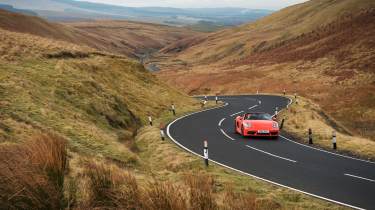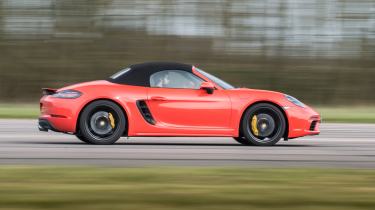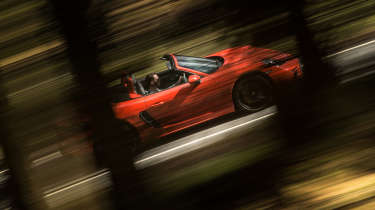Porsche 718 Boxster S 2025 review – fewer cylinder, less fun
The 718 Boxster S is undoubtedly quick and brilliant to drive, but the turbocharged four-cylinder lacks the character we've come to expect
In a fast changing performance car landscape, the Porsche 718 Boxster received not just a fresh name, but a four-cylinder engine when it was launched in 2016. Named after the 718 racing car of the Fifties and Sixties which was also powered by a flat-four engine, it's clear that Porsche put a lot behind this new unit, but it wasn't received as well as it might have hoped.
With the much-loved normally-aspirated flat-sixes temporarily retired in the pursuit of reduced emissions and improved fuel economy, the market responded accordingly. As a result, Porsche brought the naturally-aspirated flat-six back for the GTS 4.0, creating one of the best drop-top driver's cars in the process. Still, the four-cylinder remains in the entry-level Boxster and Boxster S, and it's not all bad news.
> Porsche 718 Boxster GTS 4.0 2025 review – six-cylinder drop-top is best in class
Engine, gearbox and 0-62mph time
The base 718 Boxster gets a 2-litre engine while this S model receives an uprated unit, displacing 2.5 litres for 345bhp at 6500rpm and 310lb ft of torque between 1900 and 4500rpm. The redline is set at 7500rpm – the drop off in power from the 6500rpm peak to the limiter is five per cent, which Porsche claims is a best in class figure.
More reviews
The standard transmission is a six-speed manual gearbox, but buyers can specify a seven-speed PDK twin-clutch unit – a limited-slip differential can be added as part of the Porsche Torque Vectoring package. Porsche says a 718 Boxster S with PDK will reach 62mph from standstill in 4.4sec assisted by a launch control system. The manual car records a 4.6sec 0-62mph time. Top speed is 177mph.
In an effort to retain as much of the responsive, free-revving character of the old six-cylinder engines Porsche has incorporated a handful of clever technologies into the new range of four-cylinder units. Dynamic Boost, for instance, leaves the throttle open for up to two seconds after the driver lifts off the throttle pedal, which means boost pressure isn’t dropped. When the driver reapplies the throttle, therefore, there’s no delay as boost builds back up again.
The higher-powered S model uses variable turbine geometry, a technology that filtered down from the 911 Turbo. This gives the turbocharger the response of a smaller turbo at low engine speeds with the power of a bigger turbo at higher engine speeds.
The previous Boxster’s chassis structure was carried over for this version, albeit with some important revisions. The rear axle, for example, has been strengthened to increase lateral stability and the more direct steering system from the 911 Turbo has been fitted. The Boxster S uses the 911 Carrera’s front brakes, with 330mm discs and four-piston calipers, although Porsche Carbon Ceramic Brakes are still available.
Another option is the second-tier Porsche Active Suspension Management system, called PASM sport chassis. The basic PASM option lowers the car by 10mm, but the new sport chassis version lowers it by 20mm to further drop the car’s centre of gravity. Our test car was fitted with this option, as well as ceramic brakes, Porsche Torque Vectoring, a sports exhaust and Sport Chrono, making it the 718 Boxster S in its most focused form – for the time being at least.
Ride and handling
Our car was also fitted with optional 20-inch wheels, which certainly look the part in combination with the 20mm drop in ride height. Impressively, though, ride quality in the softer PASM suspension setting is actually very reasonable. With good storage space between the two boots, a high quality cabin and a fast-operating power hood the 718 is as useable and fuss-free as two-seater sports cars get.
The Sport Chrono kit brings with it a rotary switch on the steering wheel, which allows you to choose between Normal, Sport, Sport Plus and Individual drive modes. In either of the Sport modes the 718 is a deeply impressive sports car, with an expertly judged chassis balance, good pliancy over bumps and rock solid body control.
That was all true of the previous version, too, but with the more direct steering rack, the lower ride height and the latest generation Pirelli P Zero tyres the 718 feels more agile than ever. The stiffer damper mode is worth exploring on the road – so often these firmer settings are really only appropriate for smooth circuits – because having a touch more support at each corner does take away the very small degree of floatiness in the body that can be felt in the softer mode, without completely ruining pliancy over bumps.
Steering feel was not a strength of the previous Boxster and the same is true here. In fact, the steering is exceptionally accurate and it gives a better sense of connection to the front axle than the helm in a 911, but there simply isn’t the granular feel that marked out early Boxsters.
The limited-slip differential gives the car enormous traction away from bends, but with so much more torque than before you can manipulate the attitude of the rear axle using the throttle pedal more readily, particularly in damp conditions, which makes the car really engaging and rewarding.
There is a good deal more to celebrate about the drivetrain, too, such as the sublime gearshift action. The ratios themselves are still very long, but the much stronger mid range means you needn’t hold gears quite so long or relentlessly chase the lowest gear possible, which means you can row through the gears more frequently and enjoy that gearshift action.
Even with the sports exhaust fitted the new engine is fairly characterless in the way it sounds. It doesn’t want for volume at idle and the sound is a dirty, gruff sort of warble with Subaru undertones, but it isn’t tuneful. Unfortunately, it doesn’t improve once on the move and with the roof up it’s actually very droney. The note does harden over the final 1000rpm, but the long and short of it is that the Boxster is no longer a car that can be enjoyed for the way it sounds.
The turbo announces its arrival with a real ferocity at 2800rpm, below which the engine is rather lifeless. This is demonstrably a turbocharged engine, whereas the 911 Carrera’s six-cylinder unit disguises its forced induction very effectively. Once the turbo has spooled up throttle response is brilliantly sharp and there’s such a wide power band that you never find yourself dropping off the turbo. By 6800rpm the engine has begun to run out of puff.
Straight-line performance is stronger than ever, but the intensity and excitement of the old six-cylinders has been lost. Along with the missing soundtrack that means a good chunk of the reason we’ve loved Boxsters for so long has been taken away from us.
Porsche 718 Boxster GTS 2.5 four-cylinder (2017 - 2020)
The four-cylinder Boxster GTS, axed in 2020, features a larger 2.5-litre turbocharged and dry-sumped flat-four driving the rear wheels through either a six-speed manual transmission or a seven-speed PDK automatic. Where the GTS differs from the regular Boxster S is in fine-tuning, with a revised intake duct and optimised variable-geometry turbocharger allowing Porsche to lift boost from 1.1bar to 1.3bar - the end result is 360bhp, 15bhp more than a Boxster S and 35bhp more than its naturally-aspirated predecessor.
Likewise, torque increases to 310lb ft, spread in a plateau from 1900 to 5500rpm in the manual version, or 317lb ft up to 5000rpm for the PDK. The PDK is quickest of the pair on paper owing to near-seamless gearchanges, taking only 4.1sec to reach 62mph from rest or 3.9sec in Sport Plus mode, compared with 4.4sec for the manual. Top speed is a claimed 180mph in both versions.
On a dry road, the GTS displays fantastic turn-in and strong grip, but not so much that you can’t feel the cornering load across each axle. The cornering attitude is pretty much up to you – turn in aggressively and you can let the rear do the work, or work the front tyres harder and lift off to trim your line. Feed in the power gently and there’s great traction, or jump on the throttle a little harder and enjoy the sensation of the rear tyres breaking traction allowing a few degrees of measured slip. It’s predictable, accessible, and a great deal of fun – enough to convince you there’s little point to the larger, less playful 911 Cabriolet.
Objectively the tweaked 2.5 is hard to fault, with excellent responses for a turbocharged unit and strong low- and mid-ranges that both effectively negate the bugbear of overly long gearing, and make the Boxster’s fantastic balance even more responsive to throttle inputs. Talking of gearboxes, despite the intergalactic gearing we’d still go for the six-speed manual over the seven-speed PDK. Not only is it one of the best manual gearboxes in the business, the GTS is a roadster at its best when the driver is integral to every mechanical control.
But while the extra power makes the GTS even quicker, it still won’t feed your craving for the kind of high-revs, high-fidelity tunes played by its naturally-aspirated predecessors. At low revs and under load it sounds like there’s a Massey-Ferguson on your tail, while the mid-range has more than a hint of Beetle. At higher revs you can just about kid yourself of some Impreza-style character but it’s a bit uncultured even for that, and the popping and crackling overrun in Sport is depressingly artificial – it’ll do so even if you’re pottering through a village at 2000rpm.
